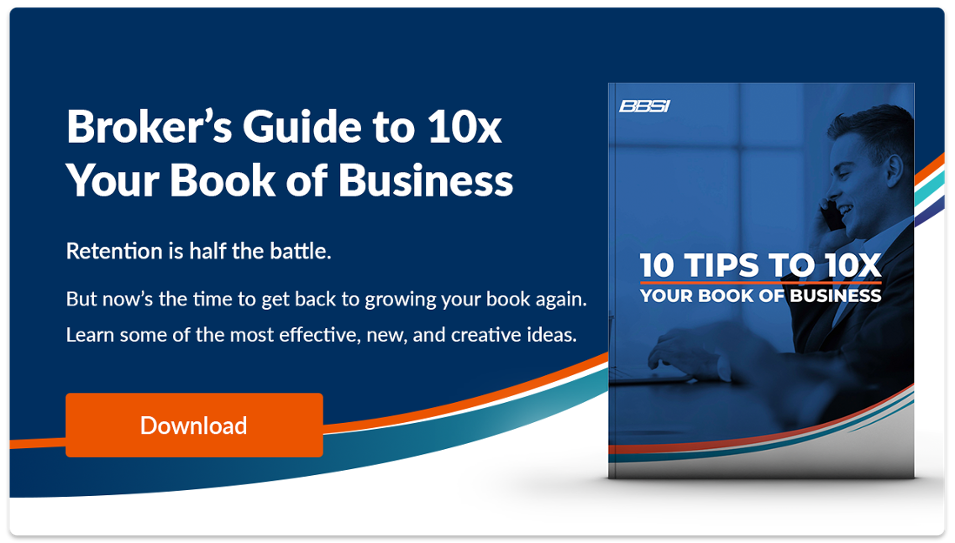How to Create a Client Referral Program That Converts

As an insurance broker, your clients are the bread and butter of your business. Depending on the relationships you have with your clients and the value you provide them, they’ve likely sent you referral business from their personal or professional networks. While unprompted referrals are flattering, brokers can harness the power of their clients’ word of mouth with a streamlined client referral program.
A recent study found that businesses using referral programs report 71% higher conversion rates than companies that don’t. This means an insurance client referral program could optimize your marketing efforts while building stronger client relationships and improving your bottom line.
Building a top-tier referral network takes front-end effort, but your business should see significant returns with the right program.
Let’s break down client referral program basics, the biggest potential benefits, and a checklist for establishing the perfect system.
What is a Client Referral Program?
A client referral program is a coordinated strategy that generates new client leads by incentivizing your existing network to recommend your business to their friends, family, and colleagues. Referrals can come from current clients, associates, professional employment organizations (PEO), consultancy services, and more.
How Can a Referral Program Help Your Business?
A client referral program helps you capitalize on positive experiences and relationships you have within your professional network to generate more business and warm leads. A referral program can significantly improve your business in a few key areas:
- Lead generation and conversion: Data shows that referral programs generate a large volume of high-quality leads. They can also decrease a company’s cost of acquisition since word-of-mouth advertising is generally free or inexpensive compared to other marketing efforts.
- Increased existing customer loyalty: If an existing client refers one or more clients to your business, they’re more likely to be long-term customers.
- Exponential network expansion: As you receive more referrals, your network of potential customers, partners, and industry contacts increases. Each new client brings a critical asset to the table — a unique network of people who can benefit from the value you provide.
- Higher quality standards: When your clients refer contacts to your business, it often means they believe you will deliver a high-quality product or service. This expectation and responsibility will help motivate any broker to constantly improve their offerings and the value they provide.
A referral program does more than bring new customers into the fold. It improves your relationship with existing clients, supports your company’s network growth, and incentivizes your brand to continually focus on quality.

How Do You Build a Client Referral Program?
Before you can begin reaping the benefits of consistent referral business, you have to build an effective program. Let’s discuss what you need to get your program up and running.
1. Complete a Quality Assurance Check-Up
Before you start asking for referrals or brainstorming incentives, make sure your business is referral-ready. Specifically, you should review the quality of a few critical areas of your business:
- Sales: While evaluating your sales team, don’t only focus on how well it converts leads into customers. You should also consider how well equipped your salespeople are to interface with potential clients. Are they helpful and personable with leads? Do they have the equipment they need to be successful? Do they need more training? It's critical for your sales team to represent your business well.
- User experience: Are you still working out kinks in your website or other client-facing applications? Now is the time to ensure that your user experience is as smooth and bug-free as possible before driving more traffic to each.
- Customer support: Are you supporting your customers’ needs effectively and efficiently? Make sure you have the bandwidth to handle all your existing clients’ needs before taking on the needs of referrals. Any gaps in this area of your business will reflect poorly on you and your referrer.
Simply put, you should tackle your outstanding to-do list before bringing in new business.
2. Find Potential Sources for Referrals
After making sure your i’s are dotted, and t’s are crossed, you can begin brainstorming a list of potential referral sources. As previously mentioned, you should look beyond your existing client roster and consider seeking referrals from second and third parties, such as:
- Brokers of different insurance products
- Professional networking groups
- Professional service providers, like banks and financial institutions, physical and virtual utility companies, suppliers, vendors and contractors
- Professional employer organizations (PEOs)
- Networking groups, like Chambers of Commerce, education and outreach programs, and philanthropic organizations
- Consultants both inside and outside your industry
While you’re creating your list of potential referrers, you should also consider which will offer the most and highest quality leads. These sources are where you should focus the majority of your marketing efforts.
3. Build a Referral Program Standard Operating Procedure (SOP)
A standard operating procedure (SOP) is a document your team can follow when working with a referred lead. You likely already have SOPs for sales, customer support, or claims departments, but you should also consider creating one for your referral program.
An SOP will benefit your program, clients and staff by making it easier for your team to ask for and follow up with referrals while streamlining the process for referrers. It should outline your process, rewards structures, branding information and basic boilerplate language employees can pull from during conversations.
Most importantly, the SOP should prioritize making it as simple as possible for both the referrer and the person being referred.
4. Identify Referral Rewards
After you’ve nailed down the basics of your program, it’s time to identify rewards for referrers that will incentivize them without breaking the bank or shrinking your profit margins. Some potential rewards for referrers include:
- Monetary rewards, like cash back, premium discounts, or gift cards
- Raffle tickets for prizes or events
- Donations to select charities
- Tickets to events or outings, such as concerts and arts events, sports games or tournaments, company-sponsored networking events, and outdoor activities like hikes or fishing trips
- Company merchandise, food, beverages, or other goods
Note: It’s important to consider whether insurance agents can give gifts for referrals in your state. In many states, insurance companies may only provide monetary referral rewards to parties who aren’t licensed to sell insurance products. This isn’t the case everywhere, and each state stipulates the types of rewards insurers can offer to clients and licensed colleagues alike.

5. Start Advertising Your Program
Once you’ve completed the planning process, it’s time to roll out your referral program. This will look different for every company, but keep the following elements in mind as you design yours:
- Consider a soft opening: Offer the plan to one or two segments of your network while you work out the kinks. You can then progressively introduce other networks to the program as you refine the system.
- Develop a unique rollout plan for each networking group: Depending on the kind of contact you’re talking to, you may want to take an individualized approach like a call or a text or send out generalized marketing via channels like social media or email.
- Consider scaling up your rewards program over time: Offer progressively larger rewards as contributors provide more referrals or as the length or value of referral contracts increases.
Whether you choose an all-hands-on-deck or a more simplified approach to marketing, you’ll need to create a general plan to attract people to participate in your program.
6. Seek Feedback and Improve Your Process
Once your referral program is in full swing, it’s important to evaluate it regularly. When you look for ways to improve your program, prioritize these three areas:
- How successful your program is compared to your team’s effort
- Client and referral satisfaction with the process
- Any new or applicable regulations or compliance requirements that may apply to your program
Consider evaluating your program quarterly, annually or biannually. Your schedule will likely depend on your company size, the age of your program, and its success.
Build a Blueprint for Success with BBSI
Building a quality referral program for your insurance business takes significant effort. However, it has the power to drastically improve your sales, profits, and customer satisfaction. And you don’t have to do it alone.
When you become a BBSI referral partner, you gain access to a team that will help you develop a referral program, as well as co-host, co-brand, and spearhead other valuable sales and marketing initiatives. With BBSI, you can also expand the services you offer your clients to include payroll, HR, business consulting, and more, creating more mutually beneficial relationships and providing more value.
Contact us to learn more.
Disclaimer: The contents of this white-paper/blog have been prepared for educational and information purposes only. Reference to any specific product, service, or company does not constitute or imply its endorsement, recommendation, or favoring by BBSI. This white-paper/blog may include links to external websites which are owned and operated by third parties with no affiliation to BBSI. BBSI does not endorse the content or operators of any linked websites, and does not guarantee the accuracy of information on external websites, nor is it responsible for reliance on such information. The content of this white-paper/blog does not provide legal advice or legal opinions on any specific matters. Transmission of this information is not intended to create, and receipt does not constitute, a lawyer-client relationship between BBSI, the author(s), or the publishers and you. You should not act or refrain from acting on any legal matter based on the content without seeking professional counsel.
